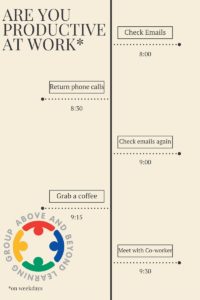
Which type of worker are you?
Which principles may be influencing your behavior at work?
How can you increase your productivity?
“I need coffee and some time to warm up before I tackle the tough stuff.” Does this sound like you? Do you find yourself knocking out easier, faster, more enjoyable tasks first thing in the morning and then working on the bigger, harder, less enjoyable projects as your work day goes on? If this is you, temporal discounting may be initially impacting your behavior. It is possible that getting the reinforcer is more valuable when it happens faster. Especially in the morning. Then, as the day goes by, as things get done, you are able to continue working and delay reinforcement longer.
An example from the Director’s desk: First thing in the morning, I check my email. I am able to quickly respond and delete mail from the Inbox. Next, I return phone messages. This takes more time but also generally low effort. Messages get deleted as well. It is initially reinforcing to delete these tasks quickly. Third, I work on small projects that are completed that same day. Finally, I choose a larger project (generally with the closest deadline) and start to work on it. It may not be completed that day. This is the longest delay in reinforcement. My behavior may not be directly reinforced again until the whistle blows for the day.
Maybe this doesn’t sound like you? Here’s another scenario.
“I am a morning person and I do my best thinking before the mid-afternoon slump begins.” If you come into work and want to tackle that big project, your behavior may be under the control of a negative reinforcement schedule. The completion of this big task may serve as the reinforcer for your work behavior. The removal of the bigger, harder task may be more valuable than crossing the easier tasks off your ‘to-do’ list.
What if you find yourself around that coffee station at the same time each day? Even without looking at the clock? Your behavior may be under the influence of a time schedule. Under these schedules, reinforcement – such as taking a break from the computer or chatting about last night’s Survivor tribal council – is delivered independent of getting any work done. It is a response independent reinforcement schedule. Regardless of whether you have a super productive morning or one where nothing really got done, you are taking that break anyway. The break is independent of your response (AKA work).
Our behavior is influenced by rules, stimulus control, reinforcement, and motivation. Paying attention to what factors are more influencing during different times of day can help us (and employers) to increase productivity.
Here are some strategies that could increase your productivity:
- Goal setting and self-monitoring (creating and checking off a ‘to-do’ list) is helpful in learning about how you work and what type of behavior principle works best for you,
- Give yourself a break or a reward after the completion of a task you don’t want to do (reinforcement),
- Have a less preferred task followed by a preferred one (still reinforcement but we call this the Premack principle),
- Find yourself escaping or procrastinating? Then program in breaks at specific times during the day to minimize escape behavior,
- Let’s get fancy! Figure out how often do you usually take a break? Let’s say every 30 minutes. Write all numbers on pieces of paper between 1-60. Once you arrive in the morning, shuffle the paper, and turn one over. Let’s say it’s 25. Work on your task list without any Facebook checks, looking at your phone for text messages, or visits to the snack room for 25 minutes. Then take a break. When you return, turn the next paper over. That is the next amount of time you need to work before your next break. Continue repeating the turn paper-work-break sequence all day. Now you’re on a variable interval reinforcement schedule.
- Try doing the same as above, but instead of the numbers representing minutes, they are the number of tasks that need to be completed before your break. So, turn over a 2. Complete 2 tasks, then take a break. Come back and turn over a 5, complete 5 tasks, take a break. Repeat! This is a variable ratio reinforcement schedule
- Work on a few easy tasks and then work on a hard task for some time. Then take a break and repeat with a few easy tasks and then working on the hard task. This is utilizing the principle of behavioral momentum through high-probability response sequences.

Leave a Reply